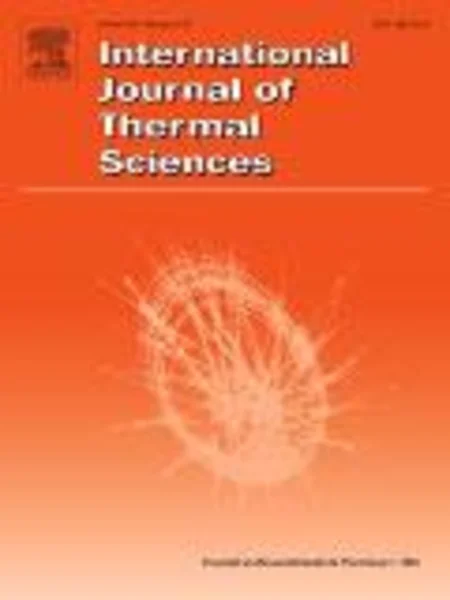-
study of mechanical disturbances effects on the laminar separation bubble by means of infrared thermography
جزئیات بیشتر مقاله- تاریخ ارائه: 1390/01/01
- تاریخ انتشار در تی پی بین: 1390/01/01
- تعداد بازدید: 598
- تعداد پرسش و پاسخ ها: 0
- شماره تماس دبیرخانه رویداد: -
the aim of this paper is to show the possibility to increase small wind turbine performances using a micro electro mechanical system (m.e.m.s.) placed inside the blade. in particular its effects on the laminar separation bubble (lsb) phenomenon are presented. this is a local boundary layer separation, that may occur on aerodynamic bodies operating at low reynolds numbers as the root blade sections of small horizontal axis wind turbine rotors. its presence induces an aerodynamic efficiency drop-off due to a drag increase and a lift decrease. tests are performed on an airfoil designed for the root section of a small wind turbine having a 10 kw nominal power. a m.e.m.s. was placed internally the wing section to produce mechanical disturbances directly inside the boundary layer; m.e.m.s.’ lower face is clamped to the wing structure, while the upper one is glued to a pvc movable strip aligned with the airfoil upper surface. m.e.m.s. was electrically supplied at different amplitudes and frequencies in order to vary vibration modes. preliminary measurements, performed by using a pressure distribution analysis, were carried out to qualitatively locate the lsb presence. laminar separation, transition and turbulent reattachment points positions are quantitatively detected by means of a thermographic approach: the heated thin foil technique is used to observe temperature distribution on the airfoil surface and a numerical energy balance approach was employed to evaluate the local convective heat transfer coefficient h. afterward the local stanton number distribution was calculated and a first and second derivatives analysis allowed to localize the lsb characteristic points positions. results showed a very effective m.e.m.s. action for frequencies about 175 hz and a reynolds number of 105. a lift increases about 50%, was showed with a consequent increase of the wind turbine cpvalues.
حوزه های تحت پوشش رویداد
مقالات جدیدترین رویدادها
-
استفاده از تحلیل اهمیت-عملکرد در ارائه الگوی مدیریت خلاقیت سازمانی و ارائه راهکار جهت بهبود
-
بررسی تاثیر ارزش وجوه نقد مازاد بر ساختار سرمایه شرکت های پذیرفته شده در بورس اوراق بهادار تهران
-
بررسی تأثیر سطح افشای ریسک بر قرارداد بدهی شرکت های پذیرفته شده در بورس اوراق بهادار تهران
-
بررسی تأثیر رتبه بندی اعتباری مبتنی بر مدل امتیاز بازار نوظهور بر نقد شوندگی سهام با تأکید بر خصوصی سازی شرکت ها
-
تأثیر آمیخته بازاریابی پوشاک ایرانی بر تصویر ذهنی مشتری پوشاک ایرانی (هاکوپیان)
-
سنتز و بررسی خواص فیزیکی الاستومرهای پلی(یورتان- اوره) تهیه شده از واکنش پیش پلیمر یورتانی بر پایه پلی کاپرولاکتون و عامل پخت تری اتیلن گلیکول بیس ( 4-آمینوبنزوات)
-
بررسی عوامل موثر بر پایایی سازه های بتنی
-
اثربخشی درمان شناختی مبتنی بر ذهن آگاهی برکمال گرایی مثبت و منفی افراد دارای ویژگی های شخصیت وسواسی_جبری
-
عوامل تاثیرگذار بر تحلیل عددی تراوش آب در خاک با استفاده از روش المان محدود و ارایه پیشنهادها
-
the effective parameters of hydrate formation in the presence of porous media
مقالات جدیدترین ژورنال ها
-
مدیریت و بررسی افسردگی دانش آموزان دختر مقطع متوسطه دوم در دروان کرونا در شهرستان دزفول
-
مدیریت و بررسی خرد سیاسی در اندیشه ی فردوسی در ادب ایران
-
واکاوی و مدیریت توصیفی قلمدان(جاکلیدی)ضریح در موزه آستان قدس رضوی
-
بررسی تاثیر خلاقیت، دانش و انگیزه کارکنان بر پیشنهادات نوآورانه کارکنان ( مورد مطالعه: هتل های 3 و 4 ستاره استان کرمان)
-
بررسی تاثیر کیفیت سیستم های اطلاعاتی بر تصمیم گیری موفق در شرکتهای تولیدی استان اصفهان (مورد مطالعه: مدیران شرکتهای تولیدی استان اصفهان)
-
بررسی رویکرد معنا درمانی به عنوان روش مشاوره توانبخشی گروهی
-
بررسی تاثیر هوش هیجانی بر فرسودگی شغلی با نقش میانجی درگیری شغلی (مطالعه موردی: کارکنان اداره پست شهر همدان)
-
ردیف و نقش آن در رباعیات خیام
-
چگونه توانستم مشکل پرخاشگری دانش آموزم محمد را برطرف سازم
-
تأثیر نقش فرهنگ سازمانی بر میزان کارایی کارکنان




سوال خود را در مورد این مقاله مطرح نمایید :